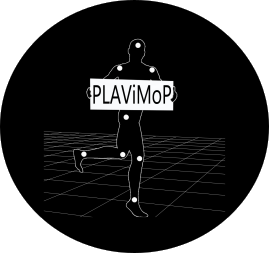
PLAViMoP Software
The main goal of PLAViMoP Software is to provide a tool that allows one to visualize and transform movements, wich are displayed as point-lights in a 3D scene.
| Software manual | Software version 2 manual |
We offer two different softwares (PLAViMoP 1 and PLAViMoP 2) which will allow you to view and / or modify animated sequences of points in .c3d format (see the “Database” page). Regardless of the software used, you will be able to transform the animated sequences into spatial and / or cinematic terms and you will be able to create a video playable on any computer. Depending on your needs, one or the other or both can be installed on a single computer.
PLAViMoP 1
PLAViMoP 1 software consists of a Matlab graphical interface that interacts with the free and open source software Mokka. This software will allow you, among other things, to have access to all of Mokka's functionalities, allowing you to visualize graphically, the coordinates of each joint (speed, acceleration, to create links between the different joints or to crop your sequences (For more details see Software 1 manual).
PLAViMoP 2
The PLAViMoP 2 software is composed of a Matlab graphical interface, which interacts with a "Moveck" viewing window. This interface will allow you, among other things, to create and save precise configurations (perspective, position of the camera, size and colors of the points) allowing you to then apply them to other sequences of movements (for more details see Software manual 2). PLAViMoP 2 also facilitates the transformation into video and allows you to preview the movement in real time as well as a perspective effect (the character grows as you approach the camera).
Summary: comparison of the functionalities of the two software
Installation requirements
- Internet connection.
- Windows, 64-bit system.
- Administrator rights.
- The minimal screen resolution is 1024 x 900 pixels. However, the application has been optimized for a 1920 x 1080 pixel screen resolution.
Tutorials
To access help videos, go to UPtube.
https://videotheque.univ-poitiers.fr/chaine/plavimop/
How to cite ?
If you use PLAVIMoP software, please cite:
Decatoire, A., Beauprez, S.A., Pylouster, J., Lacouture, P., Blandin, Y., & Bidet-Ildei, C. (2018). PLAViMoP Software: How to standardize and simplify the use of point-light displays, Behavior Research Methods, doi: 10.3758/s13428-018-1112-x.
